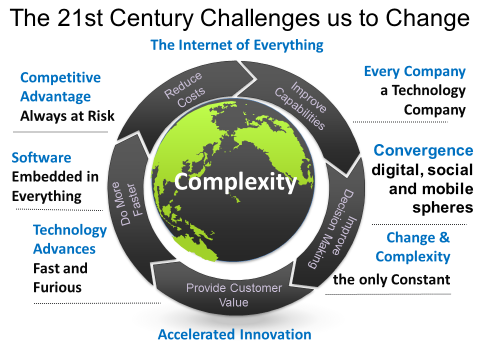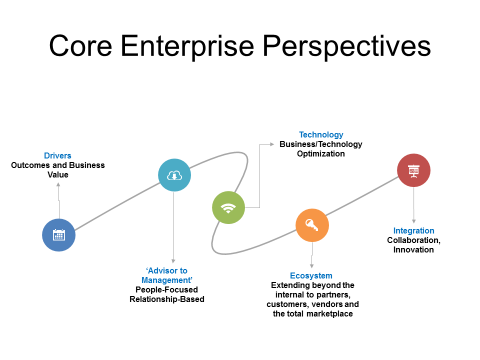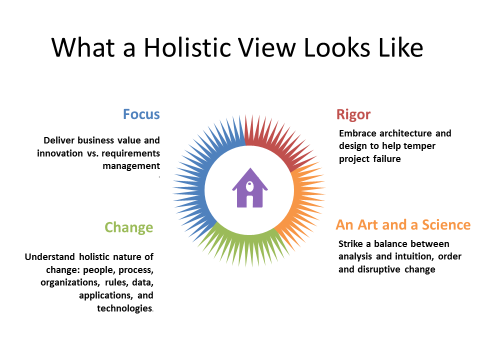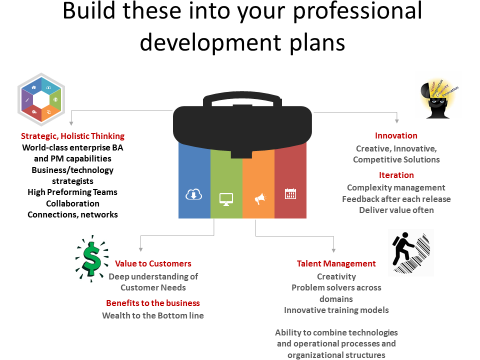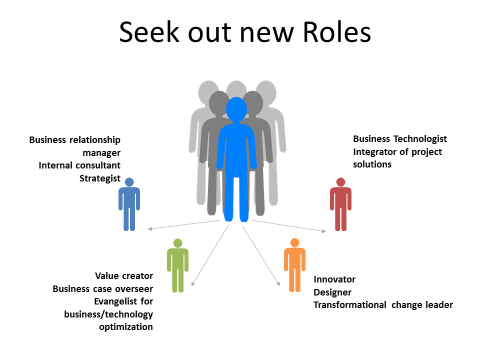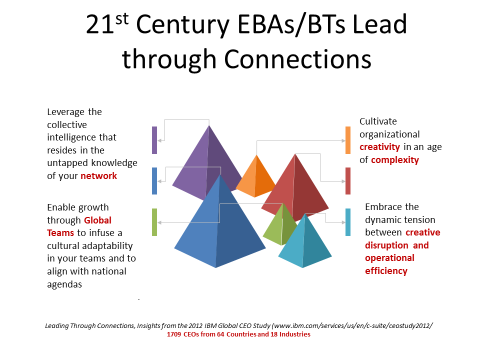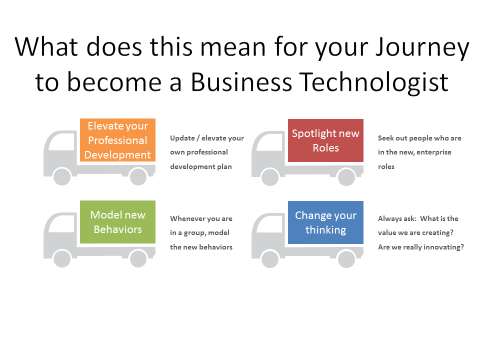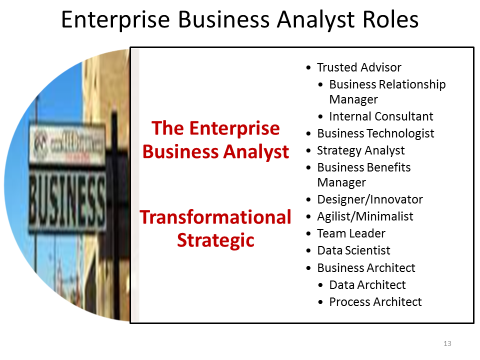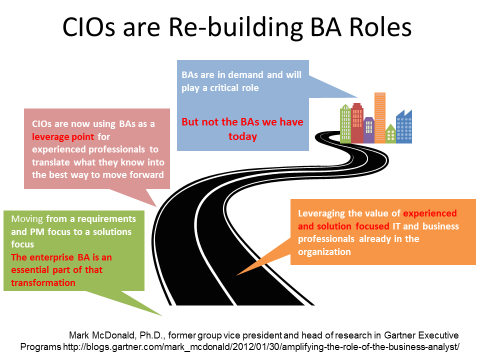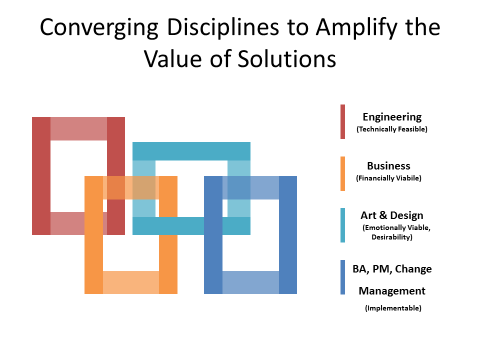Updates from BBC Vegas With Angela Wick
Angela Wick is at BBC (Building Business Capability) Conference in Las Vegas this week. Be sure to check back often for all her updates!
Update #9 – Emerging Trends in Technology and Critical Skills – Ken Fulmer
Ken gave a talk this morning on how disruptive technologies are impacting the BA work we do. This has been a major theme at the conference; so many sessions talking about this and the conference twitter storm (#BBCcon) is buzzing with tweets about it.
What strikes me about this is how easy it is to think that this is far way, or that it does not impact my org or client?
IT IS CLOSER THAN WE CAN IMAGNE! As BAs we will be impacted VERY SOON and likely already but not seeing it!
Ken covered 3 areas of impact in his presentation.
Cloud Computing and SaaS
Key impacts to BAs:
- Move to product vs. project capability and enhancing the value of the product ongoing. Short lifecycles and very frequent releases.
- As BAs we need to help the users adjust their process to fit the package and its options without code change
Artificial Intelligence
- Decisions knowledge workers make will be automated
- New Skill – How to teach a machine how to think?
- How much BA work can be automated?
- The work left of BAs will be strategic, facilitative, insightful and creative
Automation
- Things like IoT (internet of things) devices, 3D printing and Robotics
- The “digital BA” helps analyze and link all these things.
Other factors of all this that impacts our business analysis:
- More sophisticated customer and their needs are changing FAST too!
- Disruptive business models – Like Uber? – Could a disruptive start-up or disruptive change by a legacy company totally change your industry? Are you ready?
- Is your company disruptive enough?
Career challenges for BAs with this?
- Understand business models and how to influence it
- Understand how to digest and handle TONS of information and develop insights to value
- Lifetime learning – Good BAs need to get better, learn more, expand your role
Organizational Challenges:
- Invest in learning as well, develop relevant skills for teams
- Expanded role in BAs, agile teams, product owners
Shout out to all of you – Do you have a disruptive mind set? Do you know how to adjust your business analysis and decision making facilitation to account for disruption in your industry? Are you ramping up your skills?
Update #8 – Business Analysis On the Cusp of Change – Katie Bolla, KPMG & Stephen Ashworth, IIBA
IIBA commissioned a research study on Business Analysis and the results have been published and discussed this week. This morning a session on the results!
A link to download the study results is available on www.iiba.org
Three Trends:
- Technology and Data
- Sophisticated Customers
- Industry Disruption
Top CEO Concerns:
- Customer Loyalty
- Relevant products
- Not enough time to think strategically
Key Takeaways:
- Trends – How to compete in disruptive era – and where the BA fits in
- BA role moving from tactical to value centric
- Shifting expectations of business analysis skills
- More cognitive, strategic, innovative, insightful
- Delivering value and insights
- Looking at data differently. What insight does the data give not just how does it flow through a system
- Conditions for Success
- Support and awareness of business analysis in the organization
Update #7 – Crucial Conversations: 5 Critical Concepts to Help You Effectively Discuss What Really Matters Most – With Bob Prentiss, BobTheBA
It’s Friday at 8am in Las Vegas and hundreds have their coffee in hand ready for Bob to wake us up!
As BAs, we don’t have enough crucial conversations! They are needed to lead! Mastering soft skills will get us through these conversations.
Bob took us through the steps and key elements that we need to understand how to have crucial conversations. As always he provided us with great humor and entertainment along the way.

Update #6 – The Need for Agile Portfolio Management – Shane Hastie
We are just getting used to agile as a delivery model, but now do it at a portfolio level! What does this mean? Shane has set out to help us understand!
Consider your organizations project investment portfolio a backlog of projects in the organization like a backlog that gets regularly prioritized, items can come on and off and change priorities.
According to Shane, 75% of requirements change every 12 months, and this is why we need to adaptive portfolio management.
The life of a requirement is short!
So, let’s imagine requirements at the business objective level, if these are changing just as often, how can we plan our project investment in Q4 for all of the next year?
This totally resonated with me! Many leaders I work with are frustrated that they have to decide now what projects they think they will need a year from now, and then the project takes months or years to deliver. By the time the project is implemented, it is years from the idea and too much has changed since to deliver value. And, more important things have come up since! Agile portfolio management helps organizations plan and use uncertainty and change strategically in their investment and portfolio planning.
My favorite quotes from Shane’s session:
“Stop starting to start stopping”
“The essence of strategy is saying NO, not just adding another backlog item.”
“The Portfolio/Program/Program office (or PMO) should be about value facilitation, not cost and risk office.”
Lots of deep thoughts coming out of this session!
Update #5 – I Wish I could be in More than 1 place at the same time!
I can’t be in more than one place at the same time, but I wish I could!
So many great sessions from many great BATimes.com bloggers you read!
I am currently sitting in a session with Stephanie Vineyard and her co-presenter Jennifer Starkey. They are presenting on how to build tests from User Stories and connecting Features to User Stories, and acceptance tests using Gherkin language, which is business readable and also computer-readable. This enables some automated testing in their agile environment. They have about 100 people practicing writing GIVEN-WHEN-THEN statements for sample user stories.
Also this morning Clinton Ages has a session on actualizing corporate innovation.
Yesterday while in the Agile BA Panel where BATimes Blogger Kent McDonald was part of the panel, I missed out on a session with Richard Larson, and yet another session at the same time with Kupe Kupersmith and Lori Silverman.
Later today Hans Eckman, Mary Gorman, and Heather Mylan-Mains are speaking. And, tomorrow “BobTheBA” Bob Prentiss wakes us up with an 8am session.
I have also been hanging out at the Agile Open Jam area of the conference. Last year and this year I have been honored to be a facilitator at the Agile Open Jam where anyone at the conference can come by and ask a question or submit a topic for a 20 min huddle discussion with an experienced agile practitioner. The Agile Open Jam goes all day, each day of the conference and a group of experienced agile practitioners takes turns facilitating the discussions. This year the hot topics are: Product Ownership, Scaling the Product Owner Role, Difference Between Product Owner and BA, and more Product Ownership Topics! The Agile Open Jam is organized and hosted by the Agile Alliance in partnership with the conference. Below is a snapshot of what the Agile Open Jam looks like in action!
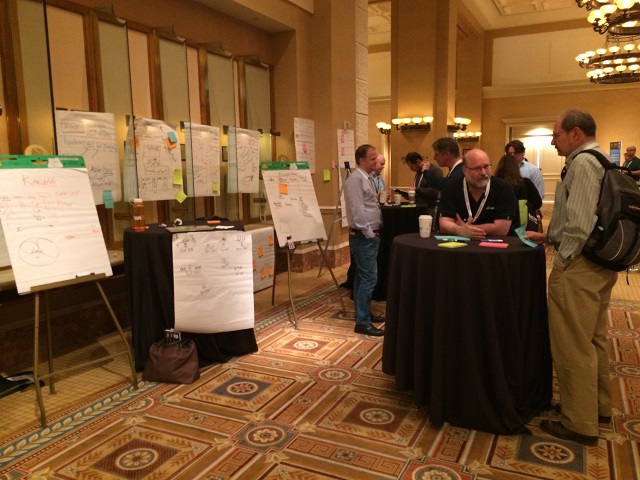
More updates coming!
Angela
Update #4 – Agile Business Analysis: Current State of the Practice
A panel discussion with Mary Gorman, Shane Hastie, James King, Kent McDonald, and Jas Phul. Moderated by Alain Arseneault
The panel is made up of part of the team creating the 2nd addition of the Agile Extension of the IIBA BABOK.
Agile BA is a HOT topic at the conference, and many are excited to hear from the panel. I have been talking to many attendees, and the Agile BA is on many minds. No longer is there a question of if a BA fits in agile, most are now talking about the various ways agile teams are using and leveraging the BA skill set and how agile teams are doing analysis.
Some key quotes from the panel:
“It’s about learning and adapting to enable our organizations to deliver faster.”
“Analysis is critical, and the BA brings those analysis skills. Asking the hard questions, identifying value, and what we shouldn’t be doing.”
“If you are a BA no matter what type, we need to understand what the actual need is. Think then act.”
“The agile manifesto is a historical document. Instead of valuing working software, we need to be valuing the outcomes are we seeing?”
How has the role of Agile BA evolved over the last 5 years?
• Focus on value and outcomes
• 5 years ago the idea of putting a BA onto an agile team was not as accepted. Today there is a recognition that product ownership is more complex, and analysis is a really important part of it, and analysis and BA brings a lot to this. Yes, that is product ownership, not just Product Owner.
• In the past 5 years, the BA work of an agile team is more evenly spread. The idea of a rigid role structure is evolving. The focus of analysis is broad, not just the next sprint.
• BA work is evolving and recognition that BAs are not replacing thinking they are facilitating thinking, helping the team analyze.
• The positive message here is as BA professionals we have the competencies that can add value to any project, even an agile context. We are really well suited to being BAs on an agile project.
“Agile should be making it quicker and easier to get the job done, not replacing the job.”
Skills needed for Agile BAs? Here is what the panel had to say:
User experience, customer experience focus, customer empathy and getting into the minds of the customer. Understanding the potentials of technology. Value stream mapping. Understanding data (model it and communicate it). Decision making, either you make the decisions, or you facilitate them and realizing what goes into making decisions. Understanding cognitive bias. Strategy, vision, goals, objectives. Deliver value every iteration! Facilitation, collaboration, negotiation, conflict resolution.
There was a discussion on what the value of the BA is in agile… and one comment that struck the audience was: Value of a BA in agile? “Turn the question around and ask: Will you take the risk of not having a BA? Are you comfortable having developers make the decisions?”
From all of this, I hope you can feel the energy around this hot topic.
Other hot topics at the conference that I hear the crowd discuss are around themes of digitalization and getting closer to the customer.
More updates soon!
Angela
Update #3 – Your Customer is Changing – IIBA Keynote – Brad Rucker
Who is your customer? Are you sure?
Brad has challenged us at BBC this afternoon to rethink who our customer really is.
He discussed “Customer Friction,” which is any interaction that has a negative impact on the customer’s experience.
So, my line of thought when listening to Brad is: How as BAs does our requirements work impact Customer Friction? Even if the process or system being built, changed or fixed is not something the customer interacts with we still need to understand the impact and friction factor from the customer perspective.
For example, how does every project you work on impact a customer touch point? The user who uses that system or process likely is using it when interacting with or serving a customer, right? Do we, as BAs know the ways in that our requirements may cause negative feelings in customers? Or are we just thinking about the internal user? Are we helping our stakeholders think through the impact of their requirements on the end customer of the organization? Are we having these conversations on projects?
Brad talked about how easy it is to lose a transaction and eventually a customer do to customer friction and negative customer experience.
Provoking thoughts!
Update #2 – BBC Keynote – The Invisible Habits of Excellence – Juliet Funt
Juliet started us off this morning with an inspiring talk about how busyness is robbing us of being thoughtful, creative, and solving problems effectively. She talks about how taking the time to “pause” stimulates better work.
Does your office have a sense of thoughtfulness?
What would it be like to work in an environment like this?
Juliet resonates with the crowd that our time is under attack!
My favorite quote from Juliet this morning:
“Our global workforce is so fried it belongs in the food court of the county fair.”
Juliet contends that when talented people don’t have time to think, business always suffers. When is the last time you caught someone thinking? Thinking changes everything, and as BAs, our job is to provide, detail, strategy, and excellence. She is asking us to think about what is it costing for us to work without thoughtfulness?
Juliet talks about how we need skills to “de-crapify” our work life, and create space and pause for thoughtfulness to truly bring out our best skills. Juliet discusses how busyness and overload might be the biggest boulder in the road for what you are trying to achieve on that project!
I can relate, can you?
Does our detailed work as BAs keep us in the micro too much? How can we come up to the macro and influence a mindset of thoughtfulness in our teams? How can you model thoughtfulness to our team when we work and inspire creativity and better problem solving?
This is deep! Yes, we as BAs impact the thoughtfulness and creativity of others we work with!
In the age of overload, we are lured into a pace and pressure that actually reduces our effectiveness.
41% of our time is being taken up by low-value tasks. Why? It is so hard to let go of unimportant things. Letting go is the path to freeing up our time to create thoughtfulness.
Juliet has truly left us inspired to rethink how we spend our time and how important space and pause is.
Later today I am looking forward to sessions from Brad Rucker on how the BA role is changing with more digital business transformation and leading our organizations towards a customer-centric future.
I am also looking forward to the session on the Current State of Agile Business Analysis, a panel discussion.
Stay tuned!
Angela
Update #1 – Live from the BBC (Building Business Capability) Conference in Las Vegas!
BBC 2016 is the official conference of the IIBA and this year brings to us:
• 1400+ attendees, from 27 different countries
• 125 sessions, 32 Tutorials, 4 Keynotes
• Agile Open Jam hosted by the Agile Alliance
• Many sponsors, networking events, and great content and learn, network, and share!
Overall the conference is looking to provide pragmatic approaches to business innovation and excellence.
I will be blogging this week on the key sessions and hot topics that are all the buzz at the event this year!
I would love to hear from you on what you want to hear about.
You can comment on the blogs or use my twitter @WickAng, or @batimes to connect with us about the show. The conference twitter hashtag is #BBCCON; myself and many others will be updating the twitter feeds often.
Monday and Tuesday this week were the pre-conference tutorials. Half day workshop tutorials that explore topics more deeply. Today – Friday are the symposium sessions where speakers from around the globe give talks on leading edge business analysis topics.
There is a great video: http://www.buildingbusinesscapability.com/why-attend/ about what BBC is all about.
I am looking forward to bringing you event happenings and updates!



